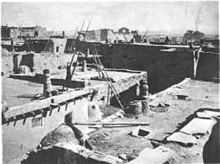Article
A roof hole is a hole in the roof of traditional pueblo structures. These holes allowed air and light to come into the dwelling and smoke to exit the dwelling, but primarily they were used to gain access to interior spaces. Until the Pueblo were influenced by European building styles, their structures did not have ground floor doors. Instead, access to interior spaces was through roof holes, using light-weight ladders that were raised and lowered as needed.
In many ways, this design echoes the way that sacred kivas are entered, through the roof, whether the kiva is erected above ground or built underground. This descent into an interior space is evocative of the Pueblo emergence from the center place of the world, through the narrow passage called the sipapu through which the people climbed at the end of their many-staged journey to the present world.
"Rooftops of Zuni Pueblo, New Mexico, circa 1880," photograph by John K. Hillers. (005030). Palace of the Governors Archive, New Mexico History Museum, Santa Fe. All Rights Reserved. Use with permission only.
Manuscripts
A01 The Blessing Way (01-07) p. 205
A01 The Blessing Way (01-07) p. 208
A01 The Blessing Way (01-07) p. 209
A01 The Blessing Way (01-07) p. 218
A03 The Boy Who Made Dragonfly (06-08) p. 27
A03 The Boy Who Made Dragonfly (06-08) p. 29
A03 The Boy Who Made Dragonfly (06-08) p. 39
A03 The Boy Who Made Dragonfly (06-08) p. 41
A03 The Boy Who Made Dragonfly (06-08) p. 50
A03 The Boy Who Made Dragonfly (06-08) p. 52
A03 The Boy Who Made Dragonfly (06-08) p. 56
References
Parsons, Elsie Worthington Clews
1929 The Social Organization of the Tewa of New Mexico. Memoirs of the American
Anthropological Association, no. 36. Menasha: The American Anthropological
Association.
Stephen, Alexander MacGregor, and Elsie Worthington Clews Parsons
1969 Hopi Journal of Alexander M. Stephen. Columbia University Contributions to
Anthropology. New York: AMS Press
Whiting, Alfred F.
1939 Ethnobotany of the Hopi. Bulletin. Flagstaff: Northern Arizona Society of Science and
Art.
Wyckoff, Lydia L.
1988 Third Mesa Hopi Ceramics: A Study of the Ceramic Domain. Ann Arbor: University
Microfilms.

